|
The Public Health Security and Bioterrorism Preparedness and Response Act of 2002 (Bioterrorism Act), section 307, added section 801(m) to the Federal Food, Drug, and Cosmetic Act to require that FDA receive prior notice for food imported or offered for import into the United States. In the preamble to the interim final rule published October 10, 2003, FDA stated that it would provide a transition period, during which it would emphasize education on prior notice requirements to help industry better comply with the regulation.
A Compliance Policy Guide was issued in December 2003 to provide guidance on the agency's strategy for enforcing and achieving compliance with the interim final rule. In accordance with this strategy, FDA is providing summary information about submission of prior notice, including data on the types of errors. This information will also be analyzed to help FDA take appropriate enforcement action when necessary.
The Summary Information is presented in two categories:
Information about both categories is in this summary along with accompanying charts. This is the fourth posting of summary information describing prior notice submissions. The August 2004 update included some summary information from December 2003 through April 2004 and some snapshots of activity in July 2004. While this fourth posting also contains updates of some of the same information, it now also includes information on specific information requirements such as registration number and carrier information. This new information is found under the headings General Interest and Specific Requirements.
Over 170,000 prior notices are submitted to FDA each week. We expect to receive about 9,000,000 prior notice submissions in FY 2005 (October 1, 2004-September 30, 2005). From December 2003 through December 2004, about 77% of prior notices were submitted as additional information on transactions submitted to the Customs and Border Protection (CBP) through its Automated Broker Interface of the Automated Commercial System (ABI/ACS). About 22% of prior notices were submitted through FDA's Prior Notice System Interface (PNSI). About half of those received through PNSI could have been submitted through ABI/ACS and the remainder was submitted for transactions that could not be accommodated by ABI/ACS. The percentage of PNSI submissions has risen steadily.
The pie charts below show that in FY2004, PNSI submissions represented around 15% (18% including PN submissions for mail shipments and personal baggage), but in FY2005 so far, PNSI submissions represent almost 18% (22% including PN submissions for mail shipments and personal baggage) of the total.
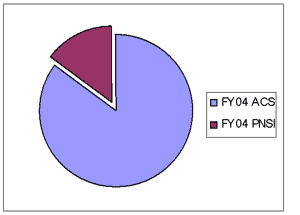 | 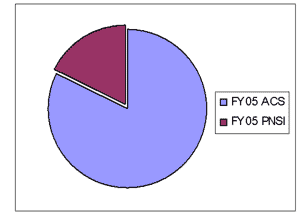 |
| Figure 1 | Figure 2 |
The chart below compares submissions from PNSI and ABI/ACS for October-December 2004 by mode of transportation. A total of 2,304,353 prior notices were submitted during this period, including submissions for mail shipments and personal baggage. About 50% of prior notices for air shipments and 11% of Road shipments were submitted through PNSI, while less than 5% of submissions for rail and sea were.
Figure 3: TOTAL SUBMISSIONS for OCT-DEC 2004 by MODE of TRANSPORTATION
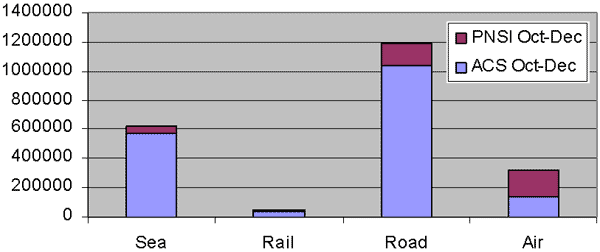
ABI/ACS: The following four graphs show submission of several key elements for those prior notices received via the Automated Broker Interface of the Automated Commercial System (ABI/ACS) in August, October, and December 2004 by mode of transportation. Compliance has steadily increased since August 2004. Submission of most of the information is at, or very near 100%, and system edits ensure that the information received is valid. Where submission has been 100% during the time period shown, e.g., FDA Product Code, the data element has not been included on the graphs.
However, several elements of planned shipment information do not reflect submission rates near or nearing 100%. For example, the container number is often not submitted for food arriving by rail and the carrier is often not provided for food arriving by road. Planned shipment information, including Bill of Lading/Airway Bill Number, Voyage Number, Container Number, etc., is required only when applicable, e.g., the Airway Bill number is required when the food is arriving by commercial air carrier, and the voyage number is required when the food is arriving by vessel. The submission rates for these data elements shown in the graphs indicate the rate at which the data element was submitted, whether or not the data element was required.
Figure 4: ACS Summary 2004 -- Sea
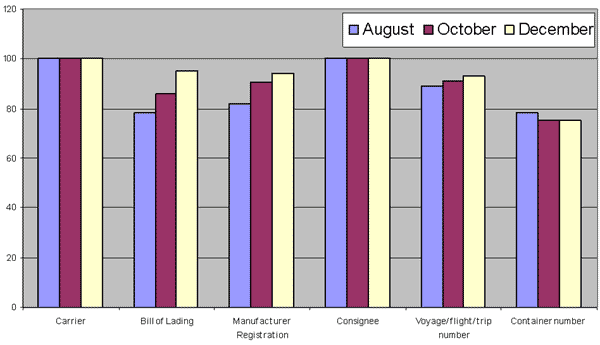
Figure 5: ACS Summary 2004 -- Air
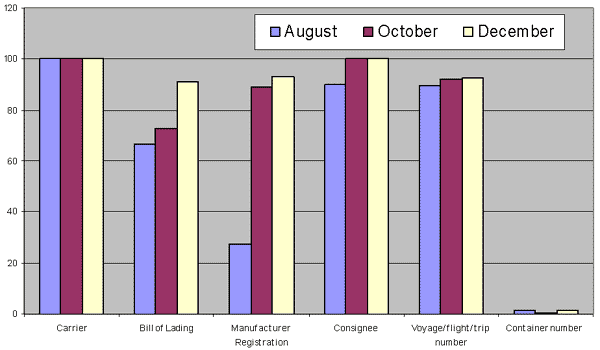
PNSI: The following four graphs show submission for several key elements for those prior notices submitted via PNSI in August, October, and December 2004 by mode of transportation. Compliance is also improving in PNSI. Since November 2004, 100% of PNSI submissions now include a manufacturer registration number or a reason code indicating why the registration number is not submitted. Where submission has been 100% during the time period shown, e.g., FDA Product Code, the data element has not been included on the graphs.
However, several elements of planned shipment information do not reflect submission rates near or nearing 100%. Planned shipment information, including Bill of Lading/Airway Bill Number, Voyage Number, etc. is required only when applicable, e.g., the Airway Bill number is required when the food is arriving by commercial air carrier, and the voyage number is required when the food is arriving by vessel. The submission rates for these data elements shown in the graphs indicate the rate at which the data element was submitted, whether or not the data element was required.
Figure 8: PNSI Summary 2004 -- Sea
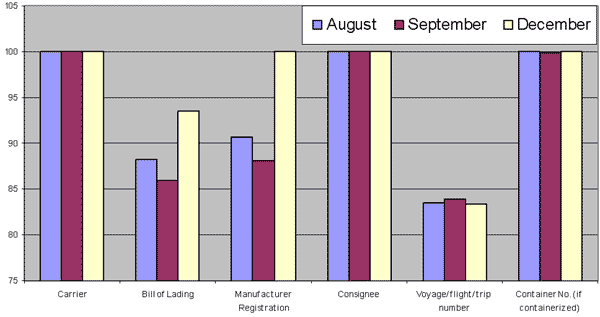
Figure 9: PNSI Summary 2004 -- Air
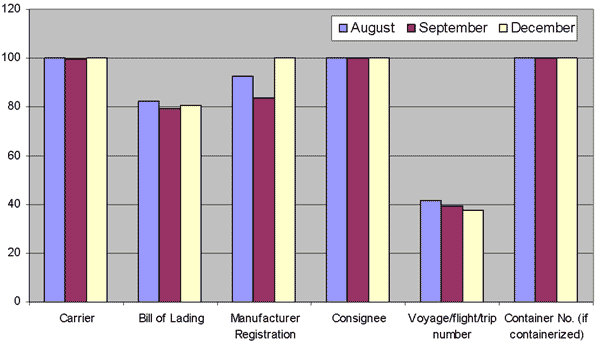
The following charts show a comparison between those submissions received via ABI/ACS and PNSI by specific information requirement and mode of transportation during the time period of August through December 2004. Taken together, these four graphs reflect some of the minor differences that result from data entry through PNSI and ACS. Most of the discrepancies that appear statistically significant reflect the different types of users, and shipments, that are being entered through PNSI.
Figure 12: Comparison of Submissions for Sea Entires from ACS and PNSI
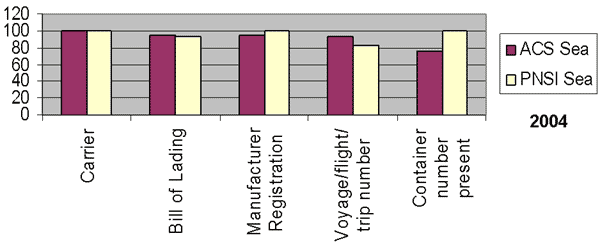
Figure 13: Comparison of Submissions for Air Entires from ACS and PNSI
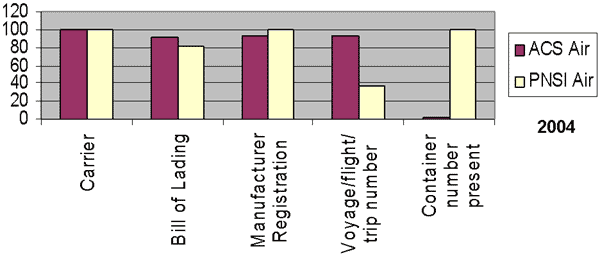
Figure 14: Comparison of Submissions for Road Entires from ACS and PNSI
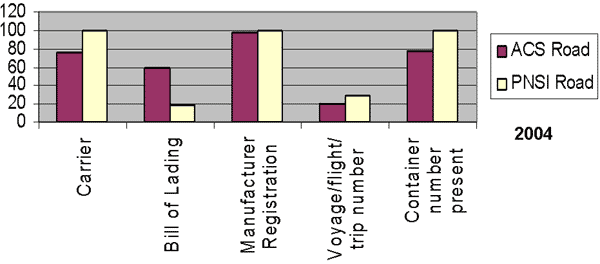
Figure 15: Comparison of Submissions for Rail Entires from ACS and PNSI
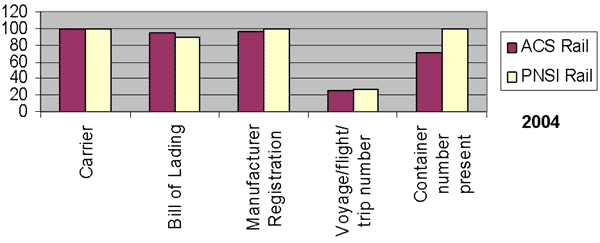
Each of the four graphs (Figures 4-7) shows changes in the rate of submission for 6 elements of information: Carrier, Bill of Lading, Manufacturer Registration, Consignee, Voyage number, and Container Number. For each of these 6 elements it shows the percent of submissions that provided information about that element in the time period ending in August, October, and November of 2004. The intent is to provide a way to see whether the rate of submission of required information is improving over that time period.
Figure 4: ACS 2004 Summary By Sea, shows that submission of Carrier and Consignee information was 100% in each of the three time periods. Submission of Bill of Lading information steadily improved; from 78% in August, 86% in October, to 95% in December. Submission of Manufacturer Registration also improved: 82%, 91% and 94% in December. Submission of Voyage information increased from 89% to 91% and was 93% in December. Submission of Container number was 78% in August but declined slightly to 75% in October and December.
Figure 5: ACS 2004 Summary by Air, also shows that submission of Carrier information was 100% in each of the three time periods. Submission of Bill of Lading information also improved for Air: from 67% in August, 73% in October, to 91% in December. Submission of Manufacturer Registration also improved. Only 27% in August, it was 89% by October and 94% in December. Consignee improved from 90% in August to 100% in October and December. Submission of Flight number information increased from 89% to 92% in October and December. Submission of Container number was less than 2% in all three periods.
Figure 6: ACS 2004 Summary by Road, shows submission of Carrier information increasing from 51% in August, to 52% in October and 77% in December. Submission of Bill of Lading information improved from 35% in August, to 44% in October, and to 59% in December. Submission of Manufacturer Registration also improved; only 84% in August, it was 93% by October and 97% in December. Consignee was at 98% during the period. Submission of trip information remained low as might be expected for vehicles on the roads: 23% in August and October and 21% in December. Container number was 66% in August, 76% in October, and 77% in December.
Figure 7: ACS 2004 Summary by Rail, shows submission of Carrier and Consignee information near 100% throughout the time period. Submission of Bill of Lading information improved from 52% in August, to 81% in October, and to 95% in December. Submission of Manufacturer Registration also improved; it was 91% in August, it was 96% by October and 97% in December. Submission of trip information remained low: 16% in August, 25% in October and December. Submission of Container number was 66% in August and October, and 71% in December. This graph also provides information on submission of rail car numbers; 36% were submitted in August, 41% in October, and 39% in December.
The next four graphs (Figures 8-11) show information on the rate of submission of certain key information requirements made through PNSI. It provides the same kind of information about PNSI submission as the previous 4 graphs did for ACS submission. Each of these four graphs shows submission information for 6 elements of information: Carrier, Bill of Lading, Manufacturer Registration, Consignee, Voyage number, and Container Number. For each of these 6 elements it shows the percent of submissions that provided information about that element in the time period ending in August, September, and November of 2004.
Figure 8: PNSI 2004 Summary Summary By Sea, shows that (like ACS) submission of Carrier and Consignee information was 100% in each of the three time periods. Submission of Bill of Lading information went from 88% in August, to 86% in September, to 93% in December. Submission of Manufacturer Registration also dipped in September: 90%, 88% but went up to 100% in December. Submission of Voyage information remained at 84%. Submission of Container number was 100%.
Figure 9: PNSI 2004 Summary by Air, also shows that submission of Carrier and Consignee information was 100% in each of the three time periods. Submission of Bill of Lading information went from 82% in August, 79% in October, to 80% in December. Submission of Manufacturer Registration improved from 92% to 84% to 100% in December. Submission of Flight information varied between 42 and 38%.
Figure 10: PNSI 2004 Summary by Road, shows submission of Carrier and Consignee information at 100% in all three periods. Submission of Bill of Lading information went up from 17% in August and September to 18% December. Submission of Manufacturer Registration also improved; only 86% in August to 100% in December. Submission of trip information remained low as might be expected for vehicles on the roads: 32% in August and 31% in September and 28% in December. Submission of Container number was 100% throughout.
Figure 11: PNSI 2004 Summary by Rail, shows submission of carrier and consignee near 100% throughout the time period. Submission of Bill of Lading information was 88% in August, to 78% in September, and to 89% in December. Submission of Manufacturer Registration also improved; it was 94% in August, it was 90% by September and 100% in December. Submission of trip information remained low: 33% in August, 26% in September and December. Container number was 100% throughout. This graph also provides submission information for rail car numbers: 41% in September, and 100% in December.
The next four graphs (Figures 12-15) show comparison between ABI/ACS and PNSI of the rate of submission of 5 information requirements by mode of transportation (sea, air, road, and rail). The each of the 4 graphs shows a comparison between ABI/ACS and PNSI for the following information requirements: carrier, bill of lading, manufacturer registration number, voyage/flight/trip number, and container number. For each of these 6 elements it shows the percent of submissions that provided information about that element in the time period ending in August, September, and November of 2004. Taken together, these four graphs reflect some of the minor differences that result from data entry through PNSI and ACS. Most of the discrepancies that appear statistically significant reflect the different types of submitters and shipments that are submitted via PNSI.
Figure 12 compares ACS and PNSI submissions for shipments by Sea. It shows that Carrier information is submitted for 100% of both ACS and PNSI prior notices. Submission of Bill of Lading information is at 95% for ACS and 93% for PNSI. Submission of Manufacturer registration is 94% for ACS and 100% for PNSI (because the system itself will not accept a prior notice without a registration number or an exemption). Submission of Voyage number is 93% for ACS and 83% for PNSI, and submission of container number is 75% for ACS and 100% for PNSI.
Figure 13 compares ACS and PNSI submissions for shipments by Air. It also shows that Carrier information is submitted for 100% of both ACS and PNSI prior notices. Submission of Bill of Lading information is slightly lower for air than for sea: 91% for ACS and 80% for PNSI. Submission of Manufacturer registration is very similar to that for sea: 93% for ACS and 100% for PNSI. Submission of Flight number is 92% for ACS and 38% for PNSI, but submission of container number is 1% for ACS and 100% for PNSI.
Figure 14 compares ACS and PNSI submissions for shipments by Road. While PNSI receives 100% submission of Carrier information because one cannot submit prior notice without it, ACS receives 77%. Submission of Bill of Lading information is 59% for ACS and 18% for PNSI. Submission of Manufacturer registration is very similar to that for 97% for ACS and 100% for PNSI. Submission of Trip number is 21% for ACS and 28% for PNSI, but submission of container number is 77% for ACS and 100% for PNSI.
Figure 15 compares ACS and PNSI submissions for shipments by Rail. Both ACS and PNSI receive 100% submission of Carrier information. Submission of Bill of Lading information is 95% for ACS and 90% for PNSI. Submission of Manufacturer registration is the same as that for road: 97% for ACS and 100% for PNSI. Submission of Trip number is 25% for ACS and 27% for PNSI, and submission of container number is 71% for ACS and 100% for PNSI.